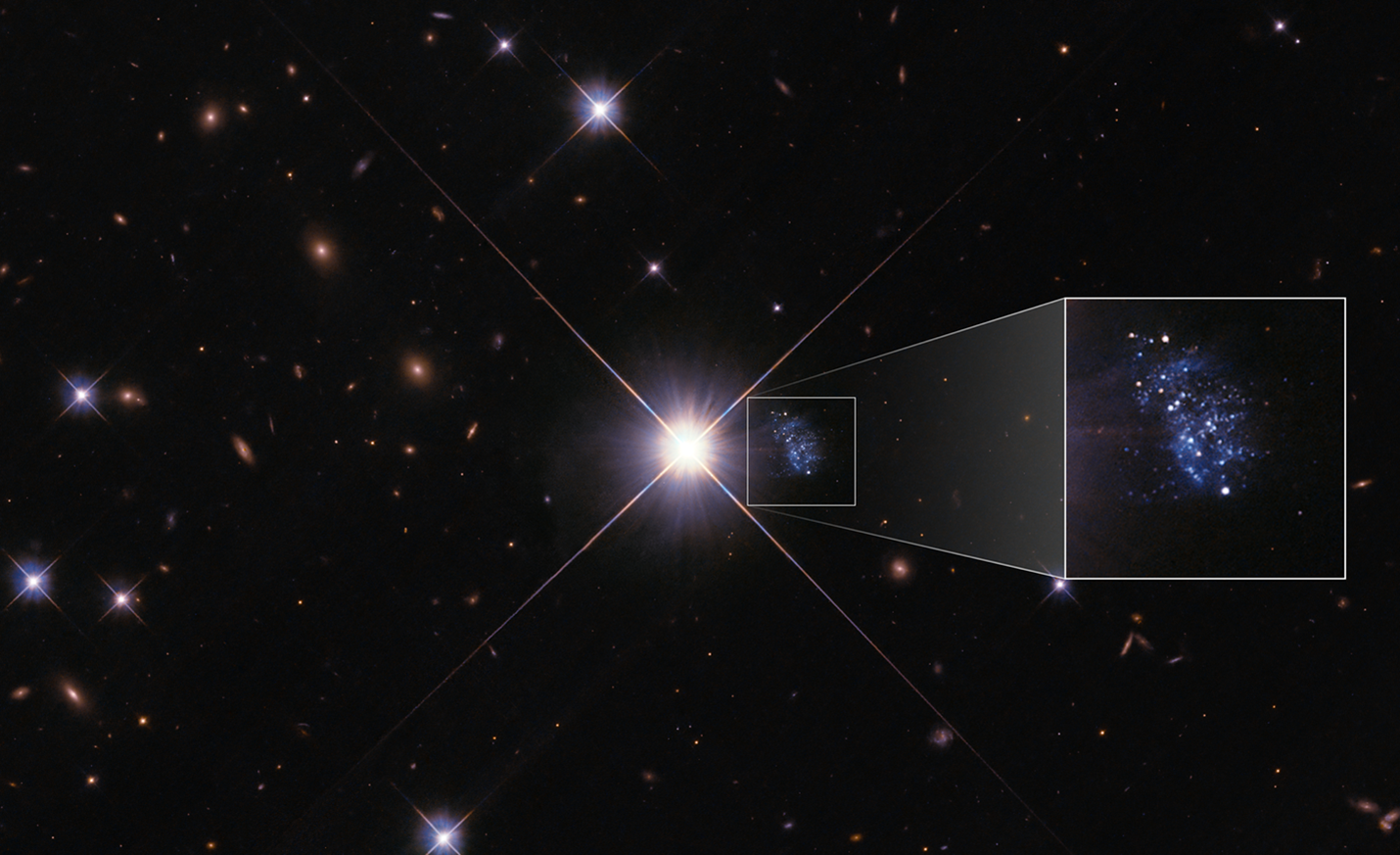by Rida Fatima

(Figure 1: Despite its proximity to a bright foreground star, NASA’s Hubble Space Telescope managed to capture a comprehensive picture of the tiny galaxy HIPASS J1131-31, also termed the “Peekaboo Galaxy.” Aside from Hubble images, astronomers used the South African Large Telescope to collect detailed spectroscopic data on the galaxy’s stars. Through this approach, it was revealed that Peekaboo is one of the tiniest chemically enriched galaxies ever noticed in the local universe. Credits: NASA, ESA, and Igor Karachentsev (SAO RAS); Image Processing: Alyssa Pagan (STScI))
A Peek Into The Past
A galaxy named HIPASS J1131-31, or Peekaboo has now come into view through an incredible picture captured by the Hubble Space Telescope. The Peekaboo galaxy is only 22 million light-years away from the Milky way galaxy. More than 20 years ago, Astronomers first detected the presence of this galaxy with the help of Australian Parkes radio telescope Murriyang, since then it was not quite visible for observation as its view was hidden by a bright star (TYC 7215-199-1) in the Milky Way. According to research, the HIPASS J1131-31 galaxy is the nearest example of the galaxy formation and development processes that occurred shortly after the big bang, which was around 13.8 billion years ago.
“Uncovering the Peekaboo Galaxy is like discovering a direct window into the past, allowing us to study its extreme environment and stars at a level of detail that is inaccessible in the distant, early Universe,” – Astronomer Gangadeep Anand
Peekaboo galaxy is described as “extremely metal-poor” by astronomers (XMP). In the beginning, the universe was constituted primarily of primitive hydrogen and helium, these were the elements created during the big bang. Throughout cosmic history, these elements formed stars that begin producing much heavier elements, eventually leading to the metal-rich universe of today. Carbon, oxygen, iron, and calcium are heavier elements “basic building blocks” that make up life as we know it. These elements were distributed throughout the universe after the supernova of metal-poor stars. Low metallicity in a galaxy is of particular interest to astronomers. It may provide critical insights not only into the chemical evolution of stars but also highlights the astrophysical events occurring in the expanding universe.
What Makes ‘Peekaboo Galaxy’ Different From Others?
Metal-poor galaxies are not very rare in the universe as they have already been discovered in our local galaxy by astronomers. However, Peekaboo is distinctive in two major ways. Firstly, it is much closer consisting of at least half the distance between it and formally known related galaxies. Moreover, it’s a metal-poor galaxy with no older stars nearby. Professor Bärbel Koribalski is an astronomer and a research scientist at Australia’s national science agency CSIRO. She is also the co-author of the latest research study on Peekaboo’s metallicity.
The Hubble telescope was able to study the composition of approximately 60 stars in the Peekaboo galaxy. Almost all of these stars appeared to be a few billion years old or younger. The Southern African Large Telescope (SALT) measurements of Peekaboo’s metallicity managed to complete the snapshot. The significant difference between HIPASS J1131-31 and other galaxies in the known universe was highlighted by these findings. Other galaxies typically have stars that seem to be billions of years old. As determined by the stars in Peekaboo, it is the youngest and slightly chemically-enriched galaxy ever revealed in the local universe. This is exceedingly rare, given that the local universe has had roughly 13 billion years to build the cosmic historical background.
Koribalski said while talking about the Peekaboo, “In the start, we were unaware of how special this little galaxy was, but now we know that the Peekaboo Galaxy is one of the most metal-poor galaxies ever detected, all credits go to data collected from the Hubble Space Telescope, (SALT) the Southern African Large Telescope, and others.”
“Because Peekaboo is so close to us, we can conduct detailed observations, allowing us to see an atmosphere like the early universe in extraordinary detail,” the astronomer Gangadeep Anand concluded.
Conclusion
Professor Bärbel discovered HIPASS J1131–31 or the Peekaboo galaxy as a region of cold hydrogen, as mentioned above. The discovery took place 20 years ago. Later on, NASA’s space-based Galaxy Evolution Explorer mission identified Peekaboo to be a compact blue dwarf galaxy using far-ultraviolet observational data. Now, Astronomers will be using the James Webb Space Telescope (JWST) alongside the Hubble Space Telescope to keep improving the snapshot of HIPASS J1131-31 obtained by Hubble findings as part of Every Known Nearby Galaxy Survey.
Bibliography
- Bowler, J. (2022, December 07). Hubble snaps a tiny, ancient-looking galaxy hiding behind a star. Retrieved from cosmosmagazine: https://cosmosmagazine.com/space/peekaboo-galaxy-hubble-parkes-star/
- Gianopoulos, A. (2022, December 06). Peekaboo! Tiny, Hidden Galaxy Provides a Peek Into the Past. Retrieved from NASA: https://www.nasa.gov/feature/goddard/2022/peekaboo-tiny-hidden-galaxy-provides-a-peek-into-the-past
- Lea, R. (2022, December 09). Peekaboo! Strange tiny galaxy provides a glimpse into the universe’s early history . Retrieved from https://www.space.com/peekaboo-dwarf-galaxy-hidden-by-star
